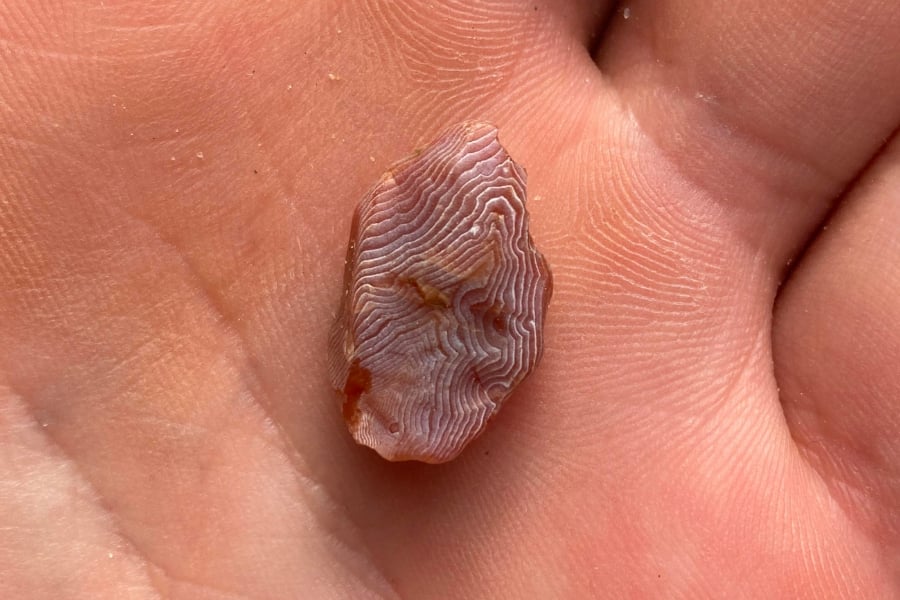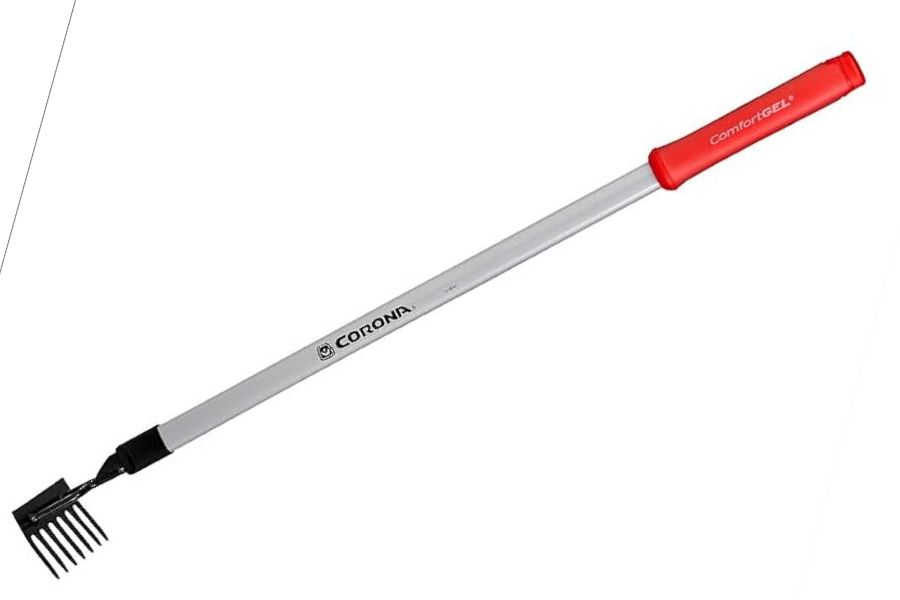Another exciting week of rockhounding has wrapped up and the Rock Chasing community has been busy! This week we’ll cover:
- Natural treasures in Barbie’s favorite color
- Different colors of cinnabar
- How valuable and pricey can limestone get
- Wonderful rocks, minerals, gems, and crystals of Arizona
- Is your citrine real?
- Why you should check out local rock and mineral shows
- How a rake has become an indispensable tool for rockhounds
- Mother and baby-shaped amethyst
All that and more below!
Win new gear in our community!
We are giving away new equipment every month to followers of our social channels. Every follow gives you another chance each month to win some great rock hammers, chisels, books, and other essential gear!
Click on the links below to sign up!
Find Of The Week

Today we have a small but impressively pretty agate from Louisiana. Amazingly, it matches our palm prints!
With its mesmerizing swirls of colors and intricate patterns, Louisiana agate is undoubtedly a captivating gem. Each piece seems like a painter’s masterpiece, capturing a kaleidoscope of hues that dance with every light reflection, leaving spectators in awe of its unique beauty.
Compared to many other gems, Louisiana agate is relatively rare, adding an extra layer of allure to its already enchanting presence. This scarcity has led to a heightened valuation among collectors and gem enthusiasts, who often seek it out for its distinct charm and unmatched brilliance.
Born from ancient volcanic activity, this gem is a result of lava trapping pockets of gas, which over millennia, became filled with silicate and various minerals. These minerals, reacting with the silicate, eventually crystallized into the stunning agates we see today.
Typically, these treasures are unearthed in the sedimentary rocks and water-worn gravels of Louisiana, especially along riverbeds where the forces of erosion bring them to light.
If you have any new finds you’d like to share with the Rock Chasing community please send them to communitysubmissions@rockchasing.com. We would love to share and will happily give you credit!
Rocks, Minerals, Gems, and Crystals in Barbie’s Favorite Color

Pink gems, crystals, rocks, and minerals are some of the world’s most stunning and sought-after. These beautiful wonders are found all over the globe and come in a wide variety of shapes and sizes.
Ancient civilizations have treasured these extraordinary specimens for thousands of years. They are believed to have spiritual and healing properties that can help bring balance to one’s life.
Pink gems, crystals, rocks, and minerals can be used for various purposes. For example, they can be worn as jewelry or kept in a pocket to bring luck or protection from evil spirits.
No matter how you use them, pink gems, crystals, rocks, and minerals will surely bring beauty and magic into your life. In this article, we’ll get to know some of the most stunning and fascinating pink natural treasures out there.
Is Your Citrine Real or Fake?

Citrine gemstones have been prized for their beauty and durability for centuries. It stands out for its radiant yellow-gold hue, which is said to bring positive energy and abundance into the wearer’s life.
However, not all citrine jewelry or specimens are created equal, and it can be challenging to tell the difference between authentic and fake citrine.
Identifying authentic specimens is pretty important since the price of citrine is often much higher than a fake. You don’t want to overpay for something created in a lab!
There has been an influx of fake citrines hitting the market as more and more are produced overseas and shipped in. They can be tricky to spot for the untrained eye, so in this article, we will share with you some easy ways to tell the difference between a real and fake citrine.
Community Tip Of The Week

Every week one of our members share a valuable tip or a big mistake they’ve made in their rockhounding journey. If you have a tip or mistake you’d like to share email us at communitysubmissions@rockchasing.com
This week’s tip comes from Jasmine in Las Vegas NV:
Check out a local rock and mineral show.
If you’ve never been to a local rock and mineral show, you’re missing out on a treasure trove of experiences and knowledge!
Stepping into one of these shows is like walking into Aladdin’s cave– tables glisten with a rainbow of crystals, fossils, and rare minerals that you’ve probably only read about. But it’s not just about admiring these wonders.
The first time I attended one, I stumbled upon a stone I couldn’t identify. A seasoned collector beside me saw my puzzled face and introduced me to the world of “fluorescent minerals” or rocks that glow under UV light. I had read about them but seeing them in person was surreal!
The conversations you’ll strike up with vendors and other enthusiasts can be incredibly enlightening. I’ve picked up countless tips on where to find specific specimens locally, how to clean and care for them, and even which tools work best in different terrains.
Plus, many shows have demonstrations, workshops, or lectures that can deepen your knowledge further!
Jasmin
Gear Spotlight – Rake

For us rockhounds, a rake is an indispensable tool that bridges the gap between surface discoveries and hidden treasures beneath layers of dirt, gravel, and sediment. At first glance, it might seem like a basic garden instrument, but to us, it’s a conduit to discovery and an extension of our own senses.
A rake is particularly needed when you are searching in areas dense with gravel or along riverbeds, where the movement of water has the potential to uncover a bounty of geological wonders.
You have two options with rakes usually, a hand rake or something a bit longer for bigger jobs. There are a couple worth looking at to get a sense for what we’re talking about:
- For hand rakes, a good starting place is the Fiskars Ergo Cultivator
- For longer rakes, there is the Corona Tools GT 3234 Reach 7-Tine Extended Rake
Both of them are sturdy, well manufactured, and will last a long time. They are also relatively light and easier to carry than a lot of other rakes out there.
With each swipe and sift, a rake is able to efficiently and effectively engage with the terrain, increasing your chances of unearthing the very gems you seek. In essence, in the hands of a rockhound, this tool becomes a vital key to uncovering the stories and secrets of our nature.
To know more about the other rockhounding equipment you should have, here is our complete guide to rockhounding gears. But if you are interested to know more about what you should consider when choosing a rake, take note of the following factors:
Durability: It should be made of sturdy material, often stainless steel or a similarly durable metal. This ensures longevity and resistance to corrosion, especially when used in wet or muddy environments.
Tine: The length and spacing of the tines are crucial. Longer tines can reach deeper into the ground, making it easier to uncover buried specimens. The spacing between the tines determines the size of the rocks or minerals that can be sifted, too.
Handle: A longer handle can provide better leverage and keeps you from bending too much. The handle’s material, whether it’s wood, metal, or fiberglass, should offer a good grip and be comfortable for prolonged use.
Weight: It should have a balanced weight. While it needs to be heavy enough to dig into the earth, it shouldn’t be so heavy that it becomes cumbersome to use over extended periods.
Weld Quality: The points where the tines are attached to the rake’s head should be strongly welded. This ensures the tines won’t easily break off when applying force.
Mother And Baby-Shaped Amethyst

Close your eyes and imagine a mother holding a baby. Now, open your eyes and look at this captivating amethyst. See the resemblance? It’s amazing!
Amethyst, with its striking purple hue, stands as one of the most iconic and recognized members of the quartz family. Its color, ranging from soft lilac to deep violet, has captivated civilizations for millennia, inspiring legends and adorning royalty.
Although it is relatively common in the gem world, its enchanting allure makes it highly valued, not just for its beauty but also for its spiritual and healing properties. Its vibrant coloration results from irradiation and the presence of trace iron impurities within its crystalline structure.
The most prolific sources of amethyst are Brazil, Uruguay, and parts of Africa, though it can be found in various regions worldwide.
A curious piece of trivia about amethyst is its name is derived from the Ancient Greek “amethystos,” meaning “not intoxicated.” The ancients believed that wearing this gem could prevent drunkenness, leading to goblets made of or adorned with amethyst.


